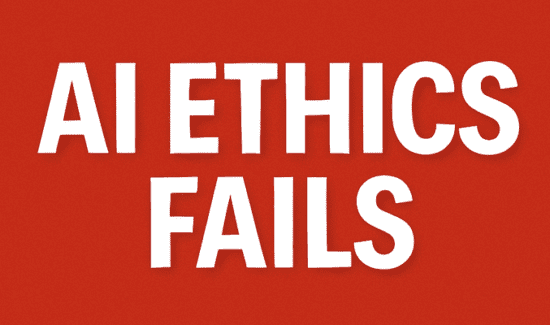An Introduction to AI Policy: Prioritizing Human-Centric AI

Solutions Review Executive Editor Tim King offers an introduction to AI policy through the lens of prioritizing human-centric AI.
Prioritizing human-centric AI is not a philosophical luxury or an aspirational ideal—it is a non-negotiable design principle for any organization that hopes to deploy AI responsibly, sustainably, and profitably in the long term. Too often, AI implementation begins with the machine and works backward to the human. This is a category error. If innovation is not augmenting human capability, improving decision-making, or preserving dignity in work, it is not innovation—it’s optimization theater in service of capital efficiency, not strategic resilience. A truly human-centric AI approach does not merely avoid harm; it actively enhances the value, agency, and well-being of the people it touches—workers, customers, partners, and citizens alike.
At its core, human-centric AI is a rejection of the myth that automation and augmentation are synonymous. Most corporate AI deployments to date have favored cost reduction and labor displacement as their north star metrics. But there is a vast difference between making a task more efficient and making a human more empowered. A task can be optimized while the worker is de-skilled or deskilled—rendered a monitor of automation rather than an actor in the system. This is not inevitable. AI can be built to elevate judgment, enhance creativity, and deepen the uniquely human capacities of empathy, context-awareness, and ethical reasoning. But that requires an intentionality of design that starts not with what the algorithm can do but what the human should do.
Important: AI Won’t Replace You, But Lack of Soft Skills Might – Get Report
An Introduction to AI Policy: Prioritizing Human-Centric AI
Human-centric AI begins with role reimagination, not task automation. The question is not: “What tasks can AI replace?” but “What new forms of contribution become possible when routine burdens are lifted?” For example, in customer support, AI should not be used to eliminate human agents but to equip them—surfacing sentiment analysis, knowledge recommendations, and language coaching in real time so that support becomes both faster and more empathetic. In manufacturing, AI should not merely optimize line productivity—it should make frontline workers safer, smarter, and more capable of orchestrating complex systems. In finance, AI should not just flag anomalies but enable analysts to reason with broader, deeper data in more creative ways.
Prioritizing human-centric AI also means rejecting the default UX assumptions of invisibility and passivity. Too many systems are designed to be “seamless,” stripping users of awareness, control, and even the right to question machine outputs. A human-centric interface does the opposite: it builds cognitive models in the user’s mind, provides meaningful choices, flags uncertainty, and allows interruption or override. Explainability is not a compliance feature—it’s a human dignity feature. And training employees on how AI works, how to interpret its suggestions, and when to override it should be treated as a core part of digital literacy, not optional professional development.
This also means placing psychological safety and human motivation at the center of AI deployment. Will a new system increase pressure, surveillance, or performance anxiety? Will it subtly devalue the employee’s contributions by forcing them into a supervisory role with no creative input? These are not abstract concerns. The erosion of workplace agency under algorithmic oversight is already well documented—in warehouses, call centers, and gig platforms. Human-centric AI requires that we not just audit models for bias, but audit deployment contexts for dignity. Technology should never coerce behavior or suppress individuality in the name of consistency.
Critically, human-centric AI does not mean halting progress or slowing transformation—it means deepening it. Organizations that embrace this principle tend to have higher engagement, stronger adoption rates, and fewer unintended consequences downstream. They build systems people want to use, not systems people are forced to tolerate. This is not just ethically correct; it is strategically wise. Human buy-in is the throttle for real digital transformation.
In practical terms, this tenet demands that firms build multidisciplinary AI design teams that include not just data scientists and engineers but ethicists, frontline workers, social scientists, and user experience researchers. It demands participatory prototyping, continuous user testing, and policy frameworks that give humans recourse, redress, and reassertion of their role as the primary agents of value. It requires AI that adapts to human context—not the other way around.
To be clear: prioritizing human-centric AI is not about putting a human in the loop for optics. It is about putting humanity in the loop for survival. In a world where machines are increasingly powerful and autonomous, it is not enough to ask what AI can do—we must relentlessly ask what AI should do, for whom, and at what cost. Anything less is reckless acceleration. Anything more is responsible leadership.
The Bottom Line
Firms should prioritize human-centric AI because the alternative—systems designed for abstract efficiency, profit maximization, or technical novelty alone—creates brittle organizations that alienate workers, degrade trust, and invite long-term risk. Human-centric AI is not about coddling sentiment or resisting progress; it is about ensuring that innovation scales with human capability, not at the expense of it. In an enterprise context, AI that augments, empowers, and respects the human workforce will always outperform AI that treats people as disposable friction. If your AI implementation devalues judgment, erodes autonomy, or diminishes employee dignity, it will fail—even if it hits its short-term KPIs.
From a business standpoint, human-centric AI drives adoption, adaptability, and alignment. Systems built with human needs in mind are more likely to be understood, trusted, and used correctly. This means fewer errors, better feedback loops, and higher ROI. In contrast, AI tools that are opaque, inflexible, or misaligned with human workflows are quietly ignored, hacked around, or weaponized in ways the developers never intended. A human-centered approach also futureproofs the organization against talent attrition and reputational damage. People don’t just want tools—they want meaning, agency, and fairness. Companies that ignore this are not just unethical; they are uncompetitive.
Delivering human-centric AI to staff begins with intentional design and cultural signaling. It starts by involving employees early—as co-designers, testers, and critics. Firms should conduct ethnographic research, participatory workshops, and behavioral simulations to understand the real pressures, desires, and frictions workers face. Then, design AI systems to enhance those roles, not replace them—through decision support, context-aware automation, or tools that offload repetitive work while preserving human oversight and creative control.
Next, firms must provide transparent communication and accessible training. Employees need to know what the AI does, why it’s being deployed, how it affects their role, and what safeguards exist. They must be given the literacy to question, override, or escalate AI behavior without fear. Training should be not just technical (how to use the tool) but philosophical (how the tool fits into human values and purpose). And finally, human-centric AI must be embedded into management philosophy. Leaders must model ethical decision-making, reward employee input, and treat AI not as a directive but as a dialog—between the organization’s ambitions and its people’s expertise.
In short, prioritizing human-centric AI is not a defensive posture—it is a performance strategy. It creates systems that work with people, not just on them. And in a world racing to automate, the firms that win will be the ones that remember why humans mattered in the first place.
Note: These insights were informed through web research and generative AI tools. Solutions Review editors use a multi-prompt approach and model overlay to optimize content for relevance and utility.



